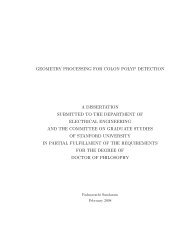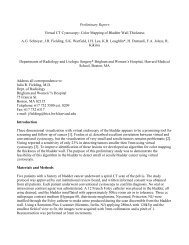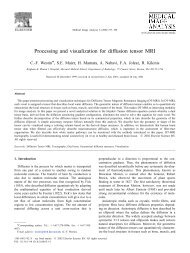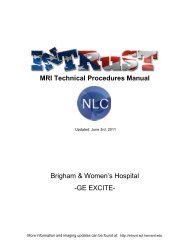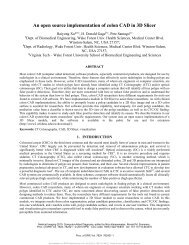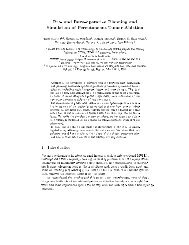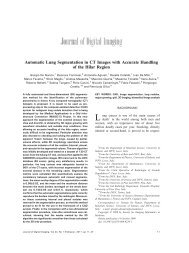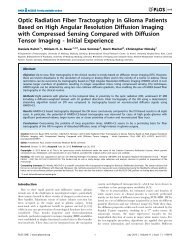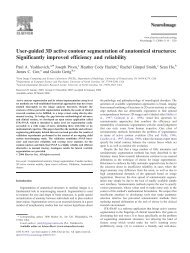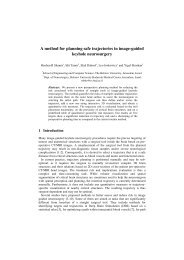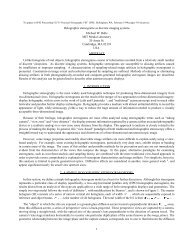Racial differences in pelvic morphology among asymptomatic ...
Racial differences in pelvic morphology among asymptomatic ...
Racial differences in pelvic morphology among asymptomatic ...
Create successful ePaper yourself
Turn your PDF publications into a flip-book with our unique Google optimized e-Paper software.
American Journal of Obstetrics and Gynecology (2005) 193, 2035–40<br />
www.ajog.org<br />
<strong>Racial</strong> <strong>differences</strong> <strong>in</strong> <strong>pelvic</strong> <strong>morphology</strong> <strong>among</strong><br />
<strong>asymptomatic</strong> nulliparous women as seen on<br />
three-dimensional magnetic resonance images<br />
Lennox Hoyte, MD, MSEECS, a John Thomas, MD, b Raymond T. Foster, MD, b<br />
Susan Shott, PhD, c Marianna Jakab, MSEECS, a Alison C. Weidner, MD b<br />
Harvard Medical School, a Boston, MA; Duke University Medical Center, b Durham, NC; Rush University, c<br />
Chicago, IL<br />
Received for publication January 6, 2005; revised May 15, 2005; accepted June 14, 2005<br />
KEY WORDS<br />
Magnetic resonance<br />
imag<strong>in</strong>g<br />
Levator ani<br />
Pelvic <strong>morphology</strong><br />
<strong>Racial</strong> <strong>differences</strong><br />
Three-dimension<br />
reconstruction<br />
Objective: Compare <strong>pelvic</strong> <strong>morphology</strong> between <strong>asymptomatic</strong> African-American and white<br />
nulliparous women.<br />
Study design: Rest<strong>in</strong>g sup<strong>in</strong>e T2-weighted magnetic resonance (MR) images were obta<strong>in</strong>ed <strong>in</strong> 12<br />
African-American (AA) and 10 white American (WA) women without <strong>pelvic</strong> floor dysfunction.<br />
Three-dimensional models were reconstructed from the MR images by a masked <strong>in</strong>vestigator, and<br />
predef<strong>in</strong>ed bony and soft tissue <strong>pelvic</strong> floor parameters were measured and compared.<br />
Nonparametric statistics were used, with significance considered at P ! .05.<br />
Results: Subjects were similar <strong>in</strong> age and body mass <strong>in</strong>dex. Levator ani volume was significantly<br />
greater <strong>in</strong> the AA versus the WA group (mean = 26.8 vs 19.8 cm 3 , P = .002). The levatorsymphysis<br />
gap was smaller <strong>in</strong> the AA (left-18.2, right-18.8 mm) versus the WA group (22.4, 22.6<br />
mm, P = .003, .048) on the left and right. Significant <strong>differences</strong> were seen <strong>in</strong> bladder neck<br />
position, urethral angle, and the pubic arch angle.<br />
Conclusion: The <strong>in</strong>creased muscle bulk and closer puborectalis attachment seen <strong>among</strong> the<br />
African-American nulliparous women may impact the development of <strong>pelvic</strong> floor dysfunction.<br />
These f<strong>in</strong>d<strong>in</strong>gs need further study.<br />
Ó 2005 Mosby, Inc. All rights reserved.<br />
Female <strong>pelvic</strong> floor dysfunction (PFD) <strong>in</strong>cludes ur<strong>in</strong>ary<br />
<strong>in</strong>cont<strong>in</strong>ence, <strong>pelvic</strong> organ prolapse (POP), fecal<br />
<strong>in</strong>cont<strong>in</strong>ence, and defecatory dysfunction. PFD is<br />
thought to stem from <strong>pelvic</strong> muscle, nerve, and connective<br />
tissue damage susta<strong>in</strong>ed dur<strong>in</strong>g vag<strong>in</strong>al childbirth. 1,2<br />
Supported by NIH R01 HD38661 and NIH: P01 CA67165-06.<br />
Presented at the 31st Annual Meet<strong>in</strong>g of the Society of Gynecologic<br />
Surgeons, April 4-6, 2005, Rancho Mirage, CA.<br />
Repr<strong>in</strong>ts not available from the author.<br />
Notably, approximately 75% of the 4 million annual US<br />
births are delivered vag<strong>in</strong>ally. 3,4<br />
There is epidemiologic evidence of a relationship<br />
between childbirth and PFD. 5 However, not all women<br />
who undergo vag<strong>in</strong>al childbirth develop PFD. 6 Further,<br />
not all nulliparous women are free of PFD. 7 In addition,<br />
some have observed anecdotally that ur<strong>in</strong>ary <strong>in</strong>cont<strong>in</strong>ence<br />
and POP may occur less often <strong>in</strong> women of<br />
African descent, when compared with white women. 8,9<br />
Work by Sze et al 10 and Handa et al 11 suggested that<br />
0002-9378/$ - see front matter Ó 2005 Mosby, Inc. All rights reserved.<br />
doi:10.1016/j.ajog.2005.06.060
2036 Hoyte et al<br />
Figure 1 A, Reconstructed dorsal lithotomy view of the bony<br />
and soft tissue pelvis. White: Pelvic bones; p<strong>in</strong>k: vag<strong>in</strong>a;<br />
yellow: urethra; brown: levator; gray: symphysis coccyx;<br />
dark blue: anal sph<strong>in</strong>cter complex; light blue: rectum. B,<br />
Bony <strong>pelvic</strong> measures: C-F: Pubococcygeal l<strong>in</strong>e; B-D: <strong>in</strong>tertuberous<br />
distance; A-E: <strong>in</strong>tersp<strong>in</strong>ous distance. The angle (B-C-<br />
D) is the pubic arch angle. The arrows po<strong>in</strong>t to the acetabulae,<br />
which are the boundaries of the <strong>in</strong>teracetabular distance.<br />
Figure 2 A, 3D soft tissue measures: The levator hiatus<br />
height is shown by the vertical white l<strong>in</strong>e. The levator hiatus<br />
width is shown by the horizontal black l<strong>in</strong>e. B, The levator<br />
symphysis gap (LSG). The right LSG is given by the white l<strong>in</strong>e,<br />
and the left by the black l<strong>in</strong>e.<br />
bony <strong>pelvic</strong> shape, rather than race, may be a factor <strong>in</strong><br />
the development of PFD <strong>among</strong> parous women. Therefore,<br />
we sought to determ<strong>in</strong>e whether there were bony<br />
and soft tissue <strong>differences</strong> <strong>in</strong> <strong>pelvic</strong> <strong>morphology</strong> between<br />
well-characterized, <strong>asymptomatic</strong> nulliparous white and<br />
African-American women. Magnetic resonance-based 3-<br />
dimensional (3D) reconstruction techniques were used<br />
as the imag<strong>in</strong>g modality because of the superior tissue<br />
def<strong>in</strong>ition and high resolution of magnetic resonance<br />
imag<strong>in</strong>g (MRI), coupled with the improved visualization<br />
of spatial relationships offered by 3D techniques.<br />
MRI has greatly improved our ability to study the<br />
organs and tissues of the pelvis <strong>in</strong> women. Standard 2D<br />
MRI has been used to assess the anatomy of the female<br />
<strong>pelvic</strong> floor <strong>in</strong> cadavers and liv<strong>in</strong>g women. 12,13 Threedimensional<br />
reconstruction offers additional advantage<br />
over 2D MRI because it affords better visual appreciation<br />
of key structures, and superior assessment of volumetric<br />
and plane geometry. 14 Further, 3D reconstruction<br />
can m<strong>in</strong>imize the artifacts possible because of variations<br />
<strong>in</strong> MR slice acquisition angle across subjects. 15<br />
Material and methods<br />
This is an Institutional Review Board-approved, prospective<br />
observational cohort study, exam<strong>in</strong><strong>in</strong>g MRI<br />
data from 2 groups of nulliparous women: 12 African-<br />
American and 10 white American. All were premenopausal,<br />
and had stage 0 or 1 <strong>pelvic</strong> support as def<strong>in</strong>ed by<br />
the POPQ system, 16 by exam<strong>in</strong>ation <strong>in</strong> the sup<strong>in</strong>e<br />
stra<strong>in</strong><strong>in</strong>g position. To be eligible for <strong>in</strong>clusion, each<br />
subject had to deny <strong>pelvic</strong> floor symptoms of chronic
Hoyte et al 2037<br />
Figure 3 A, Reconstructed side view, illustrat<strong>in</strong>g the pubococcygeal l<strong>in</strong>e (PCL, black l<strong>in</strong>e), the bladder neck to PCL (white l<strong>in</strong>e<br />
with double arrows), Bladder neck to symphysis (white l<strong>in</strong>e). B, Reconstructed side view, show<strong>in</strong>g the urethral angle, formed by the<br />
symphysis and the long axis of the urethra (white l<strong>in</strong>es).<br />
pa<strong>in</strong>, ur<strong>in</strong>ary <strong>in</strong>cont<strong>in</strong>ence, prolapse, or defecatory dysfunction.<br />
Age, height, and weight were recorded.<br />
Before MR scann<strong>in</strong>g, subjects were asked to empty<br />
their bladders. Sup<strong>in</strong>e MRI studies were performed as<br />
follows: 3D Fast Sp<strong>in</strong> Echo T2-weighted axial source<br />
images were obta<strong>in</strong>ed with the use of a 1.5T magnet<br />
(General Electric Medical Systems, Milwaukee, WI) and<br />
a torso phased-array coil wrapped around the pelvis.<br />
The follow<strong>in</strong>g imag<strong>in</strong>g parameters were used: repetition<br />
time = 4200 ms, time to echo = 108 ms, 128 phase<br />
encodes, 24-cm field of view, 2-mm slice thickness, no<br />
gap. Pixel dimensions were 0.625 ! 0.625 mm. Total<br />
scan time was 13 m<strong>in</strong>utes per subject.<br />
The MR data were transferred to a Dell Dimension<br />
8250 computer with 2 GB of RAM (Dell Inc., Round<br />
Rock, TX), and an ATI-RADEON 9800 graphics processor.<br />
The 3D Slicer software (www.slicer.org) was<br />
used to display the gray scale images and segmented<br />
label maps. A comb<strong>in</strong>ation of manual and semiautomatic<br />
techniques were used to segment the axial gray<br />
scale images <strong>in</strong>to anatomically significant organs, specifically<br />
bladder, urethra, levator complex, bony pelvis,<br />
symphysis, and coccyx, and the 3D reconstructions were<br />
made <strong>in</strong> a manner described <strong>in</strong> our previous work. 14 The<br />
reconstructed models were then displayed and the<br />
parameters measured onscreen. All MR segment<strong>in</strong>g<br />
and subsequent analysis of the result<strong>in</strong>g 3D images<br />
was performed by 1 <strong>in</strong>dividual, L.H., who was masked<br />
to subject group<strong>in</strong>g throughout these procedures.<br />
Bony pelvis parameters<br />
The bony <strong>pelvic</strong> parameters were measured on the<br />
reconstructed 3D models. Intertuberous distance was<br />
measured from midpo<strong>in</strong>t to midpo<strong>in</strong>t of the iscial tuberosities.<br />
The <strong>in</strong>tersp<strong>in</strong>ous distance was measured between<br />
the medial-most tips of the iscial sp<strong>in</strong>es. The <strong>in</strong>teracetabular<br />
distance was measured between the medial-most<br />
aspects of the femoral sockets. The pubo-coccygeal l<strong>in</strong>e<br />
(PCL) distance was measured as the distance between the<br />
<strong>in</strong>ferior-most aspect of the symphysis pubis and the tip of<br />
the coccyx <strong>in</strong> the midl<strong>in</strong>e. The pubic arch angle was
2038 Hoyte et al<br />
Table I Comparison of bony <strong>pelvic</strong> parameters between the groups<br />
PCL (mm) PUBArch (deg) InterTub (mm) InterSpi (mm) InterAcet (mm)<br />
AA<br />
Mean 91.4 99.6 119.5 105.2 117.3<br />
Range 77.3-111.5 84.6-125.2 97.7-132.9 92.3-119.9 97.4-127.6<br />
WA<br />
Mean 91.6 86.4 118.0 108.3 122.7<br />
Range 79.5-100.6 78.5-98.2 103.2-134.5 97.4-115.9 110.2-132.5<br />
P NS .006 NS NS NS<br />
PCL is the anteroposterior distance from symphysis to tip of coccyx. It is a measure of the depth of the <strong>pelvic</strong> outlet. PUBArch is the angle of the pubic<br />
arch. InterTub is the transverse distance between the middle if the iscial tuberosities. It is a measure of the width of the <strong>pelvic</strong> outlet. InterSpi is the<br />
distance between the tips of the iscial sp<strong>in</strong>es. It is a marker for the width of the midpelvis. InterAcet is the distance between the medial-most aspects of<br />
the acetabular sockets. It is a marker for the width of the <strong>pelvic</strong> <strong>in</strong>let. AA, African American; WA, White American.<br />
Table II Comparison of levator muscle parameters between the groups<br />
LHH (mm) LHW (mm) LevVOL (cm 3 ) LSGL (mm) LSGR (mm)<br />
AA<br />
Mean 56.8 31.0 26.8 18.2 18.8<br />
Range 44.2-72.7 20.1-36.1 19.0-33.9 14.6-22.4 11.3-21.9<br />
WA<br />
Mean 63.9 31.2 19.8 22.4 22.6<br />
Range 56.4-70-2 24.3-36.8 13.5-29.1 18.6-30.1 18.6-30.5<br />
P .056 NS .002 .003 .048<br />
LHH is the distance from the <strong>in</strong>ferior symphysis to the levator median raphe. LHW is the maximal transverse distance of the levator hiatus. LevVOL is the<br />
volume of the levator ani complex. LSG is the distance from the <strong>in</strong>ferior mid pubic symphysis to the nearest occurrence of the puborectalis muscle <strong>in</strong> the<br />
left (LSGL), and right (LSGR). AA, African American; WA, White American.<br />
Table III Urethral and bladder parameters<br />
BNPCL (mm) BNSym (mm) UreAng (deg) Urethra (mm) BVOL (cm 3 )<br />
AA<br />
Mean 18.11 19.0 49.2 31.6 37.7<br />
Range 7.8-28.2 11.5-22.0 40.6-62.9 23.0-40.3 12.3-138.5<br />
WA<br />
Mean 9.7 16.5 56.4 26.2 39.6<br />
Range 6.8-15.0 11.6-21.1 43.7-71.7 18.1-31.8 4.9-113.3<br />
P .001 .048 .036 .036 NS<br />
BNPCL is the perpendicular distance from bladder neck to pubococcygeal l<strong>in</strong>e-positive values lie superior to the PCL, negative values lie <strong>in</strong>ferior to the<br />
PCL. BNSym is the distance between the bladder neck and the pubic symphysis. UreAng is the angle formed by the long axes of the pubic symphysis and<br />
the urethra. Urethra is the length of the urethra along its long axis. BVOL is bladder volume. All l<strong>in</strong>ear measures are <strong>in</strong> millimeters, volumes are <strong>in</strong> cubic<br />
centimeters, and angles are <strong>in</strong> degrees. AA, African American; WA, White American.<br />
measured as the angle subtended by the <strong>in</strong>ferior pubic<br />
rami. The standard diagonal and obstetric conjugates<br />
were not available for measurement on the 3D reconstructions<br />
because the source axial scans did not reach the<br />
sacral promontory, disallow<strong>in</strong>g reconstruction of that<br />
landmark. A dorsal lithotomy view of a reconstructed<br />
bony pelvis and soft tissues is shown <strong>in</strong> Figure 1, A. Bony<br />
measurements are illustrated <strong>in</strong> Figure 1, B.<br />
Soft tissue parameters<br />
The levator hiatus height was measured <strong>in</strong> the midl<strong>in</strong>e as<br />
the distance from the <strong>in</strong>ferior-most aspect of the pubic<br />
symphysis to the <strong>in</strong>ner aspect of the levator median<br />
raphe. The levator hiatus maximum width was measured<br />
as the maximal transverse distance of the <strong>in</strong>nermost<br />
surface of the anterior levator open<strong>in</strong>g. The levatorsymphysis<br />
gap was measured as the distance from the<br />
middle of the <strong>in</strong>ferior symphysis to the nearest aspect of<br />
the puborectalis muscle on the right and left. The levator<br />
measures are illustrated <strong>in</strong> Figure 2, A and B. The<br />
bladder neck to PCL distance (BNPCL) was measured<br />
as the perpendicular distance from the posterior aspect<br />
of the bladder neck (ie, the junction of the urethra and<br />
bladder) to the PCL. Negative values of BNPCL imply a<br />
position <strong>in</strong>ferior (caudad) to PCL, positive values of
Hoyte et al 2039<br />
BNPCL imply positions superior (cephalad) to PCL.<br />
The bladder neck to symphysis was measured as the<br />
distance from the anterior aspect of the bladder neck to<br />
the closest po<strong>in</strong>t on the symphysis. The bladder neck<br />
parameters are illustrated <strong>in</strong> Figure 3, A. The urethral<br />
angle was measured as the angle subtended by the long<br />
axis of the symphysis pubis, and the long axis of the<br />
urethra, as illustrated <strong>in</strong> Figure 3, B. The urethral length<br />
was measured as the l<strong>in</strong>ear distance from distal to<br />
proximal tips of the urethra. Bladder volume, urethral<br />
volume, and levator volume were computed as the sums<br />
of the area on each slice multiplied by the <strong>in</strong>terslice<br />
distance. Levator shape was def<strong>in</strong>ed as a ‘‘U’’ if the<br />
levator moved laterally, then superiorly from its low<br />
po<strong>in</strong>t at the median raphe <strong>in</strong> the midl<strong>in</strong>e. Levator shape<br />
was def<strong>in</strong>ed as a ‘‘V’’ if it moved superiorly then outward<br />
from its low po<strong>in</strong>t at the median raphe <strong>in</strong> the midl<strong>in</strong>e.<br />
The SPSS statistical package was used for all statistical<br />
analysis (SPSS, Chicago, IL). Nonparametric Mann-<br />
Whitney tests were applied after review of frequency<br />
histograms that demonstrated non-normal data. Twotailed<br />
statistical significance is considered at P ! .05.<br />
Results<br />
Subjects did not differ by age; African-American women<br />
had a mean age GSD of 30.13 G 6.3 years versus white-<br />
American women at 26.4 G 4.4 years, P = NS. Similarly,<br />
although AA subjects had a slightly higher body<br />
mass <strong>in</strong>dex (BMI) at 26.5 (7.5) kg/m 2 versus WA<br />
subjects at 23.9 (3.3) kg/m 2 , this difference was not<br />
statistically significant.<br />
Of the bony <strong>pelvic</strong> measures, only the pubic arch<br />
angle was found to be significantly different between the<br />
groups. The pubic arch angle was larger by 13 degrees <strong>in</strong><br />
AA women versus WA women. Bony <strong>pelvic</strong> comparisons<br />
are detailed <strong>in</strong> Table I.<br />
Levator ani volume was significantly higher <strong>in</strong> AA<br />
women, who also had a significantly shorter levatorsymphysis<br />
gap bilaterally, compared with the WA<br />
women. The bladder neck was closer to the symphysis<br />
<strong>in</strong> the AA women, and the angle of the urethra to the<br />
symphysis was also smaller <strong>in</strong> this group. These <strong>differences</strong><br />
were statistically significant. Pelvic soft tissue<br />
comparisons are detailed <strong>in</strong> Tables II and III.<br />
Figure 4 shows representative 3D reconstructions<br />
from an AA and WA nulliparous women, illustrat<strong>in</strong>g<br />
the soft tissue <strong>differences</strong> between the 2 groups.<br />
Comment<br />
Our study data shows <strong>in</strong>creased levator ani muscle bulk<br />
<strong>among</strong> AA nulliparous women when compared with<br />
age-matched WA nulliparous women. In addition, the<br />
arms of the puborectalis muscle were carried closer to<br />
Figure 4 Representative reconstructions from an African-<br />
American (upper panel), and a white American (lower panel)<br />
subject. Note the bulkier levator, carried closer to the symphysis<br />
(on the left), and the smaller urethral angle (on the<br />
right) <strong>in</strong> the African-American subject.<br />
the superior pubic rami bilaterally, suggestive of a<br />
longer, denser attachment of the levator muscle to the<br />
arcus tend<strong>in</strong>eus levator ani. The bladder neck is held<br />
higher and closer to the symphysis <strong>in</strong> the AA women<br />
than <strong>in</strong> the WA women, and the pubic arch is slightly<br />
wider <strong>among</strong> the AA women. Taken collectively, these<br />
<strong>differences</strong> suggest a levator ani complex <strong>in</strong> AA subjects<br />
that is more <strong>in</strong>timately associated with its connective<br />
tissue and bony attachments.<br />
Previous <strong>in</strong>vestigators have reported strik<strong>in</strong>g <strong>differences</strong><br />
<strong>in</strong> the prevalence and <strong>in</strong>cidence of PFD <strong>among</strong><br />
different races. 8,17-22 There is, however, no consensus <strong>in</strong><br />
the medical literature on exactly how race impacts the<br />
development of PFD. Our data <strong>in</strong> this prelim<strong>in</strong>ary study<br />
suggest certa<strong>in</strong> hypotheses: it is possible that the k<strong>in</strong>d of<br />
musculoskeletal configuration we have observed <strong>in</strong> AA<br />
women, coupled with a favorably wide pubic arch, is<br />
protective aga<strong>in</strong>st <strong>pelvic</strong> floor obstetric <strong>in</strong>jury. For<br />
<strong>in</strong>stance, perhaps a bulkier levator muscle means that<br />
an AA woman can have a more extensive denervation<br />
<strong>in</strong>jury before becom<strong>in</strong>g symptomatic. Alternatively,
2040 Hoyte et al<br />
denser and longer muscle-to-connective tissue attachments<br />
may tolerate the same length of tear <strong>in</strong>jury before<br />
result<strong>in</strong>g <strong>in</strong> symptoms <strong>in</strong> AA parturients. It is <strong>in</strong>terest<strong>in</strong>g<br />
that we found a wider pubic arch <strong>in</strong> our AA subjects,<br />
which is <strong>in</strong>consistent with the classic characterization of<br />
an anthropoid <strong>pelvic</strong> shape <strong>in</strong> such women. However,<br />
the cl<strong>in</strong>ical significance of the 13-degree difference seen<br />
<strong>in</strong> the pubic arch is unclear. We speculate that our<br />
observations are <strong>in</strong> keep<strong>in</strong>g with those of Howard et al 23<br />
and Baragi et al 24 who noted more dynamic muscular<br />
attachments and a smaller overall <strong>pelvic</strong> floor area <strong>in</strong><br />
AA women. A smaller posterior pelvis was responsible<br />
for the latter f<strong>in</strong>d<strong>in</strong>g. Both of these characteristics would<br />
tend to be protective aga<strong>in</strong>st PFD by provid<strong>in</strong>g a<br />
stronger muscle travers<strong>in</strong>g a smaller <strong>pelvic</strong> floor, which<br />
would be less vulnerable to the stresses of daily life and<br />
function <strong>in</strong> our bipedal position. It may appear counter<strong>in</strong>tuitive<br />
to propose a smaller <strong>pelvic</strong> floor as be<strong>in</strong>g<br />
protective aga<strong>in</strong>st PFD, because vag<strong>in</strong>al delivery is<br />
perhaps the most consistent risk factor associated with<br />
the disease, until one considers that AA neonates are<br />
consistently of smaller average birth weight than CA<br />
neonates (http://www.marchofdimes.com/peristats).<br />
Morphologic <strong>differences</strong> <strong>in</strong> the bony pelvis between the<br />
sexes and <strong>among</strong> different races have been described 25 and<br />
are useful <strong>in</strong> archeology and forensic science. If one<br />
assumes, based on epidemiologic evidence, 8,17-22 that race<br />
is a predispos<strong>in</strong>g factor for PFD, then bony and soft tissue<br />
<strong>pelvic</strong> <strong>morphology</strong> may be critical factors that promote<br />
PFD <strong>in</strong> one race more than another. Previous <strong>in</strong>vestigations<br />
have used modern imag<strong>in</strong>g techniques to compare<br />
<strong>pelvic</strong> <strong>morphology</strong> <strong>in</strong> women with and without PFD. 10,11<br />
These studies suggest bony parameters that place women<br />
at risk for PFD <strong>in</strong>dependent of race.<br />
Although our pilot data failed to show many significant<br />
<strong>differences</strong> <strong>in</strong> bony <strong>pelvic</strong> <strong>morphology</strong> between the<br />
African-American and white groups, the <strong>differences</strong><br />
noted <strong>in</strong> soft tissue characteristics may help to account<br />
for some of the <strong>differences</strong> <strong>in</strong> PFD prevalence between<br />
parous African-American and white women. We are<br />
presently conduct<strong>in</strong>g a larger study to confirm these<br />
f<strong>in</strong>d<strong>in</strong>gs.<br />
References<br />
1. Snooks SJ, Swash M, Mathers SE, Henry MM. Effect of vag<strong>in</strong>al<br />
delivery on the <strong>pelvic</strong> floor: a 5-year follow-up. Br J Surg 1990;77:<br />
1358-60.<br />
2. DeLancey JOL, Kearney R, Chou Q, Speights S, B<strong>in</strong>no S. The<br />
appearance of levator ani muscle abnormalities <strong>in</strong> magnetic resonance<br />
images after vag<strong>in</strong>al delivery. Obstet Gynecol 2003;101:<br />
46-53.<br />
3. Menacker F, Curt<strong>in</strong> SC. Trends <strong>in</strong> cesarean birth and vag<strong>in</strong>al birth<br />
after previous. Natl Vital Stat Rep 2001 2001;49:1-16.<br />
4. Mart<strong>in</strong> JA, Park MM, Sutton PD. Births: prelim<strong>in</strong>ary data for<br />
2001. Natl Vital Stat Rep 2002 2002;50:1-20.<br />
5. Hendrix SL, Clark AM, Nygaard I, Aragaki A, Barnabei V,<br />
McTiernan A. Pelvic organ prolapse <strong>in</strong> the Women’s Health<br />
Initiative: Gravity and gravidity. Am J Obstet Gynecol 2002;186:<br />
1160-6.<br />
6. Rortveit G, Daltveit AK, Hannestad YS, Hunskaar S. Ur<strong>in</strong>ary<br />
<strong>in</strong>cont<strong>in</strong>ence after vag<strong>in</strong>al delivery or cesarean section. N Engl J<br />
Med 2003;348:900-7.<br />
7. Buchsbaum GM, Ch<strong>in</strong> M, Glantz C, Guzick D. Prevalence of<br />
ur<strong>in</strong>ary <strong>in</strong>cont<strong>in</strong>ence and associated risk factors <strong>in</strong> a cohort of<br />
nuns. Obstet Gynecol 2002;100:226-9.<br />
8. Bump RC. <strong>Racial</strong> comparisons and contrasts <strong>in</strong> ur<strong>in</strong>ary <strong>in</strong>cont<strong>in</strong>ence<br />
and <strong>pelvic</strong> organ prolapse. Obstet Gynecol 1993;81:421-5.<br />
9. Sampselle CN, Harlow SD, Skurnick J, Brubaker L, Bondarenko<br />
I. Ur<strong>in</strong>ary <strong>in</strong>cont<strong>in</strong>ence predictors and life impact <strong>in</strong> ethnically<br />
diverse perimenopausal women. Obstet Gynecol 2002;100:1230-8.<br />
10. Sze EHM, Kohli N, Miklos JR, Roat T, Karram MM. Computed<br />
tomography comparison of bony pelvis dimensions between<br />
women with and without genital prolapse. Obstet Gynecol 1999;<br />
93:229-32.<br />
11. Handa VL, Pannu HK, Siddique S, Gutman R, VanRooyen J,<br />
Cundiff G. Architectural <strong>differences</strong> <strong>in</strong> the bony pelvis of women<br />
with and without <strong>pelvic</strong> floor disorders. Obstet Gynecol 2003;<br />
102:1283-90.<br />
12. Strohbehn K, Ellis J, Strohbehn JA, Delancey JOL. Magnetic<br />
resonance imag<strong>in</strong>g of the levator ani with anatomic correlation.<br />
Obstet Gynecol 1996;87:277-85.<br />
13. Tunn R, Delancey JOL, Howard D, Ashton-Miller J, Qu<strong>in</strong>t LE.<br />
Anatomic variations <strong>in</strong> the levator ani muscle, endo<strong>pelvic</strong> fascia,<br />
and urethra <strong>in</strong> nulliparas evaluated by magnetic resonance imag<strong>in</strong>g.<br />
Am J Obstet Gynecol 2003;188:116-21.<br />
14. Hoyte L, Schierlitz L, Zou K, Flesh G, Field<strong>in</strong>g JR. Two and 3<br />
dimensional MRI comparison of levator ani structure, volume and<br />
<strong>in</strong>tegrity <strong>in</strong> women with stress <strong>in</strong>cont<strong>in</strong>ence and prolapse. Am J<br />
Obstet Gynecol 2001;185:11-9.<br />
15. Hoyte L, Ratiu P. L<strong>in</strong>ear measurements <strong>in</strong> 2-dimensional <strong>pelvic</strong><br />
floor imag<strong>in</strong>g: the impact of slice tilt angles on measurement<br />
reproducibility. Am J Obstet Gynecol 2001;185:537-44.<br />
16. Bump RC, Mattiasson ABK, Brubaker LP, DeLancey JO,<br />
Klarskov P, Shull BL, et al. The standardization of term<strong>in</strong>ology<br />
of female <strong>pelvic</strong> organ prolapse and <strong>pelvic</strong> floor dysfunction. Am J<br />
Obstet Gynecol 1996;175:10-7.<br />
17. Duong TH, Korn AP. A comparison of ur<strong>in</strong>ary <strong>in</strong>cont<strong>in</strong>ence<br />
<strong>among</strong> African American, Asian, Hispanic, and white women. Am<br />
J Obstet Gynecol 2001;184:1083-6.<br />
18. Grodste<strong>in</strong> F, Fretts R, Lifford K, Resnick N, Curhan G. Association<br />
of age, race, and obstetric history with ur<strong>in</strong>ary symptoms<br />
<strong>among</strong> women <strong>in</strong> the Nurses’ Health Study. Am J Obstet Gynecol<br />
2003;189:428-34.<br />
19. Hendrix SL, Clark A, Nygaard I, Aragaki A, Barnabei V,<br />
McTiernan A. Pelvic organ prolapse <strong>in</strong> the women’s health <strong>in</strong>itiative:<br />
gravity and gravidity. Am J Obstet Gynecol 2002;186:1160-6.<br />
20. Kl<strong>in</strong>gele CJ, Carley ME, Hill RF. Patient characteristics that are<br />
associated with urodynamically diagnosed detrusor <strong>in</strong>stability<br />
and genu<strong>in</strong>e stress <strong>in</strong>cont<strong>in</strong>ence. Am J Obstet Gynecol 2002;186:<br />
866-8.<br />
21. Knobel J. Stress <strong>in</strong>cont<strong>in</strong>ence <strong>in</strong> the black female. S Afr Med J<br />
1975;49:430-2.<br />
22. VanDongen L. The anatomy of genital prolapse. S Afr Med J<br />
1981;60:657-9.<br />
23. Howard D, Delancey JO, Tunn R, Ashton-Miller JA. <strong>Racial</strong><br />
<strong>differences</strong> <strong>in</strong> the structure and function of the stress ur<strong>in</strong>ary<br />
cont<strong>in</strong>ence mechanism. Obstet Gynecol 2000;95:713-7.<br />
24. Baragi RV, DeLancey JOL, Caspari R, Howard DH, Ashton-<br />
Miller JA. Differences <strong>in</strong> <strong>pelvic</strong> floor area between African-American<br />
and European American women. Am J Obstet Gynecol<br />
2002;187:111-5.<br />
25. Patriqu<strong>in</strong> ML, Loth SR, Steyn M. Sexually dimorphic <strong>pelvic</strong><br />
<strong>morphology</strong> <strong>in</strong> South African whites and blacks. Homo<br />
2003;53:255-62.



